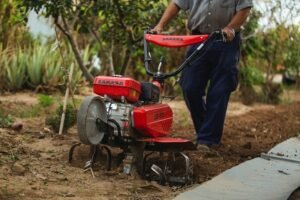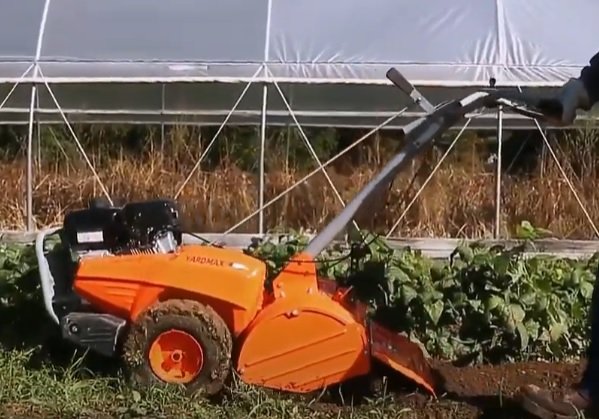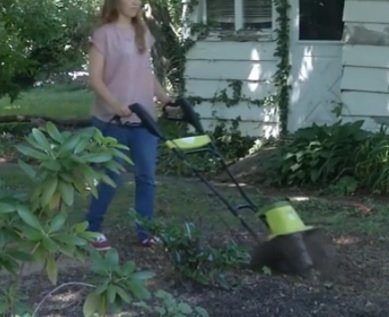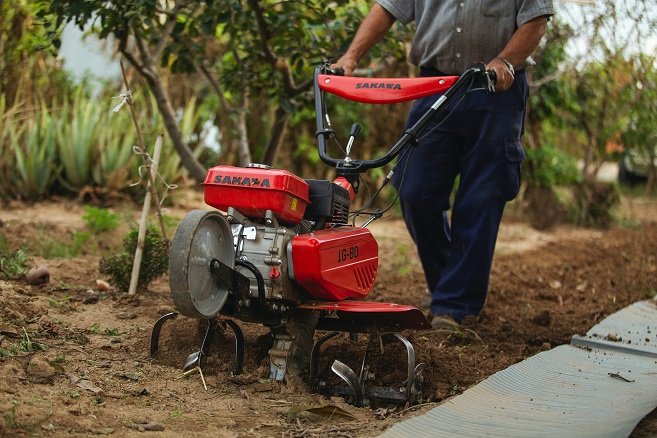We're an affiliate
We hope you love the products we recommend! Just so you know, we may collect a share of sales or other compensation from the links on this page. Thank you if you use our links, we really appreciate it!
Do you want a garden but don’t want to till the soil by hand? You’re probably wondering, how does a garden tiller work? In this article, we are going to breakdown how they work. Specifically, we are going to be discussing rear tine vs front tine, and gas-powered vs electric powered.

Hopefully, this article will give you a good understanding of which type of garden tiller is right for you and your garden.
Garden Tiller Basics
A garden tiller is a tool that is used to loosen and aerate soil to prepare for planting. The goal is to pulverize the dirt to make it easier to plant. There are different tillers on the market, but they all operate basically the same.
The most common type of tiller is the rotary tiller (sometimes called rototiller or rotovator). These machines feature spinning blades or tines that work to chop up and loosen soil as you guide it along. The tines are engaged by the person using the tiller. A squeeze grip is used to tighten the belt that drives the tines.
A depth guide attached in the frame’s rear controls the depth that the tiller tills. Some garden tillers can cultivate the soil to an eight-inch depth.
Rotary tillers are available in both rear-tine and front-tine models. Rear-tine tillers are typically more powerful and can handle tougher soil conditions, while front-tine tillers are smaller and easier to maneuver.
Most tillers are gas-powered, but there are also electric models available. Gas-powered tillers typically have more power and can cover more ground more quickly. The gas engines can sometimes be difficult to start and may require more maintenance than electric models. Electric tillers are quieter and easier to use, but they may not have enough power to tackle very tough soil conditions.
How Does A Rear Tine Garden Tiller Work?
A rear tine garden tiller has rotating tines on the back end of the machine. These tines dig into the ground and chop up the soil. This machine is self propelled and pulls itself through the garden at a slower speed than the tines will turn, allowing them to do their job.

Rear tine tillers are available in both gas-powered and electric versions. The gas-powered models are more powerful and can tackle tougher soil conditions. Electric models are mostly powered by an extension cord, although Ryobi makes a battery-powered rear tine tiller. Both types of tillers require some assembly and preparation before use, so be sure to read the instructions carefully before getting started.
The main advantage of a rear tine tiller is they are self propelled. They will not wear you out having to turn them around for the next pass through the garden. You can run some rear tine tillers with one hand.
Rear tine tillers can also carry a larger engine, which means they can do a thorough job in one pass. They are also balanced with counterweights to make them easier to operate.
The disadvantage of a rear tine tiller is they can’t get into tighter areas or close to buildings or walls. They are also more expensive than the front tine models.
How Does A Front Tine Garden Tiller Work?
A front tine garden tiller comprises a set of rotating blades or tines that are attached to a frame. The frame is mounted on wheels so the user can push and maneuver the tiller.
The tines on a front tine garden tiller are what do the actual work of loosening and aerating the soil. The tiller will pull itself along by the rotating tines.

With no resistance, the tiller will walk across the ground. To create the resistance, tillers have a depth selector rod that is adjustable. The depth selector is at the back of the tiller and will sink into the ground to keep the tiller from lurching ahead. By lifting slightly on the handles, the tiller will pull itself forward, tilling the soil as it goes.
Front tine garden tillers can be powered by either gas or electricity. Gas-powered models are more powerful, but they are also more expensive and require more maintenance.
Electric-powered models are less powerful but are cheaper to operate and require less maintenance. Electric powered tillers can be small or large. You can find them either corded or cordless.
What Are The Benefits Of Using A Gas Powered Garden Tiller?
If you’re looking for a powerful and efficient way to till your garden, you might use a gas-powered tiller. There are several benefits of using a gas-powered tiller over other types of tillers, including:
Gas-powered tillers are more powerful than electric tillers. This means that they can quickly churn through even the toughest soil, making light work of what would otherwise be a backbreaking job.
Another benefit of using a gas-powered tiller is that they are more durable than other types of tillers. This means that they will last longer and stand up to heavy use better than electric tillers.
What Are The Benefits Of Using An Electric Powered Garden Tiller?
There are many benefits of using an electric powered garden tiller. One of the main benefits is that they are much quieter than gas-powered tillers. This is important if you have close neighbors or if you want to use your tiller early in the morning, disturbing no one. Electric tillers also don’t produce any fumes, so they are better for the environment.
Another benefit of electric tillers is that they are typically lighter than gas-powered tillers. This makes them much easier to maneuver and carry around, especially if you have a small garden. Electric tillers also are more affordable than gas-powered tillers.
Be careful that you don’t run over the extension cord.
If you are looking for a garden tiller that is easy to use and won’t break the bank, an electric powered tiller is a great option!
How Do You Choose The Right Size Garden Tiller For Your Needs?
There are a few things to consider when purchasing a garden tiller. The size of your garden is the most important factor in determining the size of the tiller you need. If you have a small garden, a small tiller will be sufficient. For larger gardens, you’ll need a mid-size or full-size tiller.
The type of soil in your garden is also important. If you have hard, compacted soil, you’ll need a tiller with more power to break through it. For softer soils, a less powerful tiller will be sufficient.
Finally, consider how often you’ll be using the tiller. If you only need it for occasional use, a less expensive model will suffice. If you plan on using it frequently, it’s worth investing in a higher quality model that will last longer and perform better.
Buy, Borrow or Rent
If you don’t want to spend a lot of money buying a tiller, find one you can borrow. Short of that, many rental companies will rent you a tiller for a very reasonable price. That way, you can get your garden tilled without the hassle of maintaining and storing a bulky piece of equipment.
Buy Used
If you are independent minded or live in an area that doesn’t have a rental company, you will need to buy your own. Keep in mind that you don’t have to buy a brand new one. Check around for used equipment. You can sometimes get a real good deal.
Conclusion
A garden tiller can make quick work of preparing a planting area in your garden. The rotating tines on the tiller loosen and aerate the soil as they rotate. This allows for better drainage and root growth for your plants. There are two types of garden tillers: rear tine and front tine. Gas-powered tillers are more powerful, but require more maintenance than electric powered tillers. Choose the right size tiller for your needs by considering the size of your garden and the type of soil you will be tilling.

